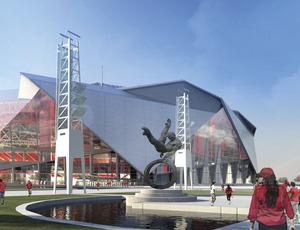

HOK looms large in the memory of Bill Johnson—the architect for the daring New Atlanta Stadium—as having set inadvertently, yet fortuitously, his career path.
In 1983, HOK established HOK Sport, triggering a minor exodus of sports architects from HNTB, where Johnson had been working for only six months.

|
| JOHNSON |
HOK currently looms even larger for the accidental sports architect. This month, his 10-year-old firm, 360 Architecture, became HOK's new sports, recreation and entertainment practice. "I had never worked for HOK until now," says Johnson, a design principal.
The 200-person 360, which dropped its name, sold itself because it wanted a bigger platform to do larger jobs. HOK was looking for a sports practice because its own sports group left in 2009 to become Populous.
HOK calls 360 the "world's most innovative" stadium designer, an opinion confirmed by Johnson's transformable design for the future home of the National Football League's Atlanta Falcons.
Tired of operable-roof venues that are basically boxes with sliding lids, Johnson wanted a kinetic sculpture. The stadium, under construction since last spring, will have a center roof section that opens like a camera lens, surrounded by fixed panels that bend to form walls. Windows will offer views of the city, and a 58-ft-tall video scoreboard will ring the roof opening.
"It's like Bill is on a never-ending quest to create a sensational game-day experience," says Bill Hellmuth, president of HOK, which has 1,800 employees in 25 offices. "Whether that means optimizing a venue's technology, establishing the most user-friendly layout or giving fans the absolute best amenities, he is passionate about enriching the spectator experience."
The 360 team was the dark horse in the Falcons stadium competition. Johnson went for broke, brazenly engaging the selection panel in the interview. The firm handed out props, including decks of cards comprising what-if questions: "What if you could create a game-day experience that pulled fans away from the comfort of home?" and "What if select seats shook during a hard hit?" and "What if you just hired us right now?"
The architect's out-of-the-box concepts won the design team the commission for the $1.4-billion development. "What drew us to Bill was the fact that he and his team blew up current thinking in designing a sports and multipurpose venue," says Rich McKay, Falcons president and CEO. "His approach was to re-imagine the stadium experience in every way. As a result, Bill set a new standard in the NFL and across multipurpose facilities."





